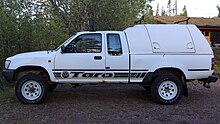| Volkswagen Taro (Typ 7A) | |
|---|---|
 Volkswagen Taro Volkswagen Taro | |
| Overview | |
| Manufacturer | Volkswagen Commercial Vehicles Toyota Hino |
| Also called | Toyota Hilux/Pickup |
| Production | February 1989–March 1997 |
| Assembly |
|
| Body and chassis | |
| Class | light commercial vehicle |
| Body style | Pickup truck |
| Layout | Longitudinal front engine; rear-wheel drive (4x2), or four-wheel drive (4x4) |
| Powertrain | |
| Engine | |
| Transmission | 5-speed manual |
| Dimensions | |
| Wheelbase |
|
| Length |
|
| Width |
|
| Height |
|
| Chronology | |
| Predecessor | Volkswagen Caddy |
| Successor | Volkswagen Amarok |
The Volkswagen Taro 1 tonne pickup truck was introduced in January 1989 by Volkswagen Commercial Vehicles to complement the half tonne Caddy pickup / panel van ranges, and the 1 tonne Transporter van and chassis cab ranges. The name "tarō" is a suffix used in Japanese to denote the oldest brother or son, or the first-born son of a family.
The Taro was a project of badge engineering. The Taro was a rebadged fifth generation Toyota Hilux, which was fully engineered and designed by Toyota. The two companies came together in an effort to solve each other's problems:
- Volkswagen Group at the time did not have a one-tonne pickup truck.
- Toyota wanted a bigger European market share of the one-tonne utility market.
History

In the late 1980s, Volkswagen Group and Toyota signed an agreement that Volkswagen Commercial Vehicles would assemble the Toyota Hilux at its VWCV factory in Hanover, Germany, and it would be sold under the Volkswagen Taro moniker.
The first Taros manufactured in Hanover, Germany, from 1989-1994 had a 2.4-litre diesel engine with 61 kW (83 PS; 82 bhp), torque was 165 N⋅m (122 lbf⋅ft) at 2,400 rpm, with loading space of 3.4 square metres (37 sq ft) and a 1,125 kg (2,480 lb) payload. The Hanover plant only built the Taro with two-wheel drive and a regular cab, although the "Volkswagen Taro" name was used for other versions imported from Japan in some European markets.
In September 1994 at the IAA Nutfahrzeuge (Commercial Vehicle Fair) in Hanover, Germany, Volkswagen released the four-wheel drive version of the Taro which had an extended cabin. The 4x4 Extended Cab Taro was manufactured in Toyota's Tahara plant in Japan, but now the Taro had an updated 2.4-litre diesel engine which produced 58 kW (79 PS; 78 bhp) at 4,000 rpm and torque of 163 N⋅m (120 lbf⋅ft) at 2,400 rpm. The 4x4 Taro had a 2.9 square metres (31 sq ft) loading space and 815 kg (1,797 lb) payload, but could tow 750 kg (1,653 lb) without brakes, and 2,100 kg (4,630 lb) with brakes.

The joint venture ended in 1997, due to sales failing to meet either car marque's expectations.
Specifications
- engine ID code, displacement, configuration and rated power output
- 2Y: 1.8-litre inline four OHV petrol engine with carburettor, 61 kW (83 PS; 82 bhp) at 4,000 rpm
- 4Y: 2.2-litre inline four OHV petrol engine with carburettor, 69 kW (94 PS; 93 bhp)
- 2L: 2.4-litre inline four indirect injection SOHC diesel engine, 61 kW (83 PS; 82 bhp) at 4,000 rpm, 165 N⋅m (122 lb⋅ft) at 2,400 rpm
- 22R: 2.4-litre inline four SOHC petrol engine with Bosch L-Jetronic injection, 82 kW (111 PS; 110 bhp)
- driveline
- 4x2 = RWD, 4x4 = 4WD
- loading area (m²)
- (4x2) 3.1m² (4x4) 2.9m²
- track width - front
- (4x2) 1,355 millimetres (53.3 in), (4x4) 1,430 millimetres (56.3 in)
- track width - rear
- (4x2) 1,370 millimetres (53.9 in), (4x4) 1,425 millimetres (56.1 in)
- turning circle
- (4x2) 12.6 metres (41.3 ft), (4x4) 14.0 metres (45.9 ft)
- permissible total weight
- (4x2) 2,395 kg (5,280 lb), (4x4) 2,515 kg (5,545 lb)
- payload
- (4x2) 995 kg (2,194 lb), (4x4) 815 kg (1,797 lb)
- trailer weight braked
- (4x2) 1,800 kg (3,968 lb), (4x4) 2,100 kg (4,630 lb)
- trailer weight unbraked
- 750 kg (1,653 lb)
- maximum speed km/h
- (4x2) 145 km/h (90.1 mph), (4x4) 130 km/h (80.8 mph)
- acceleration - 0-80 km/h (49.7 mph)
- (4x2) 15.0 secs, (4x4) 17.0 secs
- fuel consumption
- (4x2) 9.6 litres per 100 kilometres (29 mpg‑imp; 25 mpg‑US), (4x4) 10.2 litres per 100 kilometres (28 mpg‑imp; 23 mpg‑US)
Specifications Source
Successor
Volkswagen Commercial Vehicles division sells the Volkswagen Amarok pick-up, which competes against the Nissan Navara and Toyota Hilux.
The Amarok is available in single and double cab versions, as well as the option of 2WD or 4WD and high torque diesels.
References
- ^ Volkswagen Taro Press Release. Jan 1989.
- ^ Rex, Rainer, ed. (July 1989), Lastauto Omnibus Katalog 1990 [Truck and bus catalog] (in German), vol. 19, Motor-Presse-Verlag GmbH und Co. KG, pp. 44–45, 81531/89001
- Volkswagen Taro Press Release. Sep 1994.
- ETKA
External links
- Volkswagen-Commercial-Vehicles.com - official international portal
| Volkswagen Commercial Vehicles | |||||
|---|---|---|---|---|---|
| A marque of the Volkswagen Group See Also: Volkswagen Passenger Cars | |||||
| Current models | |||||
| Discontinued models |
| ||||
| Concept Vehicles | |||||
| Campervans | |||||
| See Also | |||||
| Volkswagen Commercial Vehicles, a marque of the Volkswagen Group, car timeline, European market, 1950–present | |||||||||||||||||||||||||||||||||||||||||||||||||||||||||||||||||||||||||||||||||||||||||||||||||||||||||||||||||||||||||||||||||||||||||||||||||||||||||||||||||||||||||||||||||||||||||||||||||||||||||||||||||||||||||||||||||||||||||||||||||||||||||||||||||||||||||||||||||||||||||||||||||||||||||||||||||||||||||||||||||||||||||||||||||||||||||||||||||||||||||||||||||||||||||||||||||||||||||||||||||||||||||||||||||||||||||||||||||||||||||||||||||||||||||||||||||||||||||||||||||||||||||||||||||||||||||||||||||||||||||||||||||||||||||||||||||||||||||||||||||||||||||||||||
|---|---|---|---|---|---|---|---|---|---|---|---|---|---|---|---|---|---|---|---|---|---|---|---|---|---|---|---|---|---|---|---|---|---|---|---|---|---|---|---|---|---|---|---|---|---|---|---|---|---|---|---|---|---|---|---|---|---|---|---|---|---|---|---|---|---|---|---|---|---|---|---|---|---|---|---|---|---|---|---|---|---|---|---|---|---|---|---|---|---|---|---|---|---|---|---|---|---|---|---|---|---|---|---|---|---|---|---|---|---|---|---|---|---|---|---|---|---|---|---|---|---|---|---|---|---|---|---|---|---|---|---|---|---|---|---|---|---|---|---|---|---|---|---|---|---|---|---|---|---|---|---|---|---|---|---|---|---|---|---|---|---|---|---|---|---|---|---|---|---|---|---|---|---|---|---|---|---|---|---|---|---|---|---|---|---|---|---|---|---|---|---|---|---|---|---|---|---|---|---|---|---|---|---|---|---|---|---|---|---|---|---|---|---|---|---|---|---|---|---|---|---|---|---|---|---|---|---|---|---|---|---|---|---|---|---|---|---|---|---|---|---|---|---|---|---|---|---|---|---|---|---|---|---|---|---|---|---|---|---|---|---|---|---|---|---|---|---|---|---|---|---|---|---|---|---|---|---|---|---|---|---|---|---|---|---|---|---|---|---|---|---|---|---|---|---|---|---|---|---|---|---|---|---|---|---|---|---|---|---|---|---|---|---|---|---|---|---|---|---|---|---|---|---|---|---|---|---|---|---|---|---|---|---|---|---|---|---|---|---|---|---|---|---|---|---|---|---|---|---|---|---|---|---|---|---|---|---|---|---|---|---|---|---|---|---|---|---|---|---|---|---|---|---|---|---|---|---|---|---|---|---|---|---|---|---|---|---|---|---|---|---|---|---|---|---|---|---|---|---|---|---|---|---|---|---|---|---|---|---|---|---|---|---|---|---|---|---|---|---|---|---|---|---|---|---|---|---|---|---|---|---|---|---|---|---|---|---|---|---|---|---|---|---|---|---|---|---|---|---|---|---|---|---|---|---|---|---|---|---|---|---|---|---|---|---|---|---|---|---|---|---|---|---|---|---|---|---|---|---|---|---|---|---|---|---|---|---|---|---|---|---|---|---|---|---|---|---|---|---|---|---|---|---|---|---|---|---|---|---|---|---|---|---|---|---|---|---|---|---|---|---|---|---|---|---|---|---|---|---|---|---|---|---|---|---|---|---|---|---|---|---|---|---|---|---|---|---|---|---|---|---|---|---|---|---|---|---|---|---|---|---|---|---|---|---|---|---|---|---|---|---|---|---|---|---|
| |||||||||||||||||||||||||||||||||||||||||||||||||||||||||||||||||||||||||||||||||||||||||||||||||||||||||||||||||||||||||||||||||||||||||||||||||||||||||||||||||||||||||||||||||||||||||||||||||||||||||||||||||||||||||||||||||||||||||||||||||||||||||||||||||||||||||||||||||||||||||||||||||||||||||||||||||||||||||||||||||||||||||||||||||||||||||||||||||||||||||||||||||||||||||||||||||||||||||||||||||||||||||||||||||||||||||||||||||||||||||||||||||||||||||||||||||||||||||||||||||||||||||||||||||||||||||||||||||||||||||||||||||||||||||||||||||||||||||||||||||||||||||||||||
| |||||||||||||||||||||||||||||||||||||||||||||||||||||||||||||||||||||||||||||||||||||||||||||||||||||||||||||||||||||||||||||||||||||||||||||||||||||||||||||||||||||||||||||||||||||||||||||||||||||||||||||||||||||||||||||||||||||||||||||||||||||||||||||||||||||||||||||||||||||||||||||||||||||||||||||||||||||||||||||||||||||||||||||||||||||||||||||||||||||||||||||||||||||||||||||||||||||||||||||||||||||||||||||||||||||||||||||||||||||||||||||||||||||||||||||||||||||||||||||||||||||||||||||||||||||||||||||||||||||||||||||||||||||||||||||||||||||||||||||||||||||||||||||||